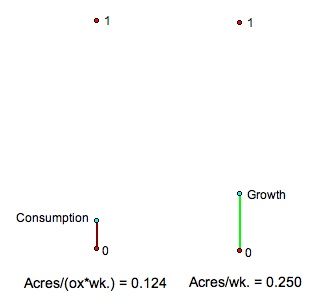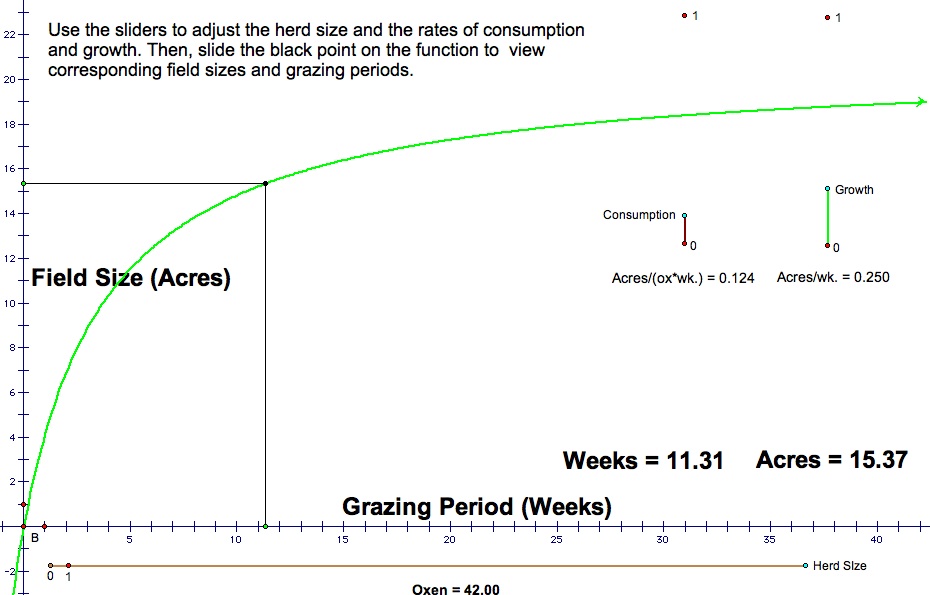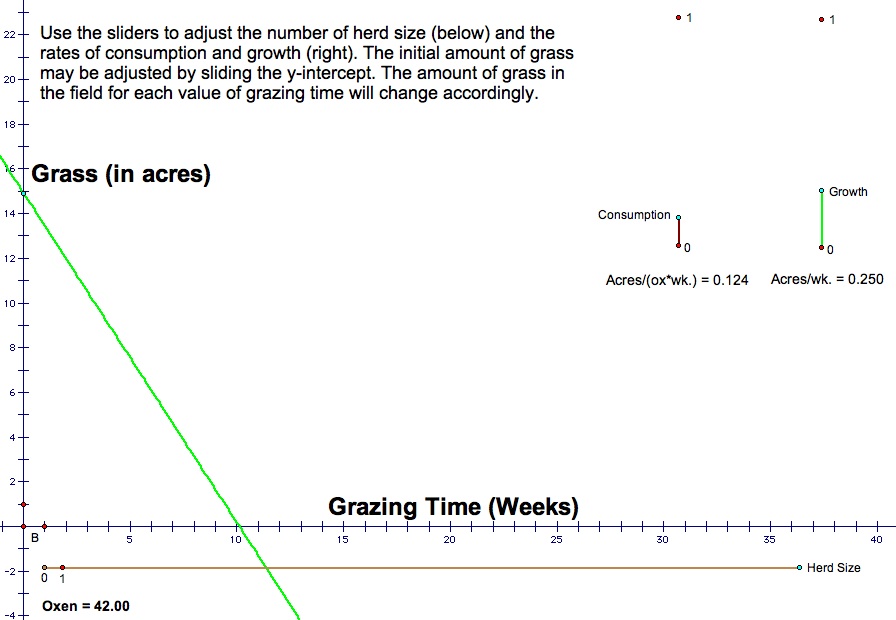
The Oxen Problem
by Kyle Schultz

The Oxen Problem
by Kyle Schultz
In his book, Mathematical Wrinkles, Samuel Jones presents the following problem:
If 6 acres of grass, together with what grows on the 6 acres during the time of grazing, keep 16 oxen 12 weeks, and 9 acres keep 26 oxen 9 weeks, how many oxen will 15 acres keep 10 weeks, the grass growing uniformly all the time? (Jones, 1930, p. 3)
This problem is complicated, as it involves a variety of factors. In each example given, the number of acres, the amount of time, and the number of oxen change. These changes make it difficult to create a mental picture of what is going on. How do changes in these parameters affect each other? Can a model be established to easily predict one value (number of acres, weeks, or oxen) if the other two are given? Can this model be adapted if the initial conditions are changed?
While an algebraic solution can be readily demonstrated, the power of technology can provide a much richer view of the mathematics involved. This essay will show how technological tools such as the Geometer's Sketchpad and Microsoft Excel can be used to such a purpose.
An Algebraic Approach:
My initial attempt to solve the problem involved solving a system of equations. First, recall the conditions described in the problem.
Acres |
Oxen |
Weeks |
6 |
16 |
12 |
9 |
26 |
9 |
15 |
? |
10 |
To create equations that model the initial conditions, two variables must be defined:
g is the amount of grass that grows on one acre in one week.
o is the amount of grass eaten by one ox in one week.
Using these variables, I constructed equations using this format:
grass grown prior to grazing + grass grown during grazing - grass consumed during grazing = 0
I let the number of acres express the amount of grass grown prior to grazing. Thus the amount of grass on one acre is simply "1". While there are many ways the amount of grass on one acre could be expressed (number of bushels, cubic meters, etc.), letting the amount equal 1 gives me a value that can be easily worked with. The values of g and o will be some fraction of 1, making their interpretation simple. The grass grown during grazing is calculated by finding the product of the number of acres, the number of weeks, and the rate of growth, g. The amount of grass consumed during grazing is calculated by finding the product of the number of oxen, the number of weeks, and the rate of consumption, o. The resulting equations for the first two sets of initial conditions are:
6 + (6)(12)(g) - (16)(12)(o) = 0
9 + (9)(9)(g) - (26)(9)(o) = 0
This presents a system of equations with two equations and two unknowns. The solution of this system is:
g = 1/4
o = 1/8
Thus, one fourth of the grass is replaced each week, while each ox consumes one eighth of an acre of grass. The solution appears by substituting these values into an equation describing the third set of conditions (15 acres, 10 weeks).
15 + (15)(10)(1/4) - (n)(10)(1/8) = 0
15 + 37.5 - 1.25n = 0
n = 42
To summarize, it will take 42 oxen 10 weeks to clear the 15 acres of grass. While this solution is correct and efficient, it does not give much insight to the mathematics behind the problem and how the different parameters affect each other. I have created two tools, one with Microsoft Excel and one with Geometer's Sketchpad, that are useful in further exploring this problem.
Using a Spreadsheet to Explore the Problem
Spreadsheets are a useful means of exploring a problem such as this for different values. To access a Microsoft Excel spreadsheet I created to interact with this problem, Click Here. Here is a brief description of the spreadsheet's features:

The yellow block, found at the top of the sheet, contains the information describing the initial conditions. These conditions mirror those stated in the problem above, but can also be modified in order to explore the mathematics behind it. If the initial conditions are changed, the rates displayed in the pink block will adjust automatically.

Below are three green blocks, representing a solver for the three variables presented in the problem: the size of the field (in acres), the amount of time (in weeks) and the number of oxen. While they currently contain the values dictated by the problem above, they can also be changed for the purpose of exploring the mathematics. To find the number of oxen needed to clear a field of a given size in a given amount of time, use the Oxen Solver (this is what would provide the solution to the problem presented above). To determine how long a field of a given size could sustain a given number of oxen, use the Weeks Solver. To determine the size of a field needed to sustain a given number of oxen for a given amount of time, choose the Acres Solver. Below each solver is a table displaying the amount of grass remaining after a given number of weeks, measured in terms of acres of ungrazed grass. These tables indicate how quickly the amount of grass changes and can be expanded to show longer periods of time.
Using Geometer's Sketchpad to Explore the Problem
The graphing capabilities and dynamic nature of Geometer's Sketchpad can provide valuable assistance in working with this problem. To access a sketch I created, Click Here. It is important to note that, unlike Excel, it is very difficult to get exact values with Geometer's Sketchpad. This is due to the the program's inability to show tiny adjustments in the measurement of objects. For example, a segment may have a length of 15.03. When the user tries to adjust the length to 15.00 by shortening the segment, the next measurement displayed is 14.98. Despite these inaccuracies in calculation, there is still much to be learned through the use of Geometer's Sketchpad with this problem. Here is a description of the sketch's features:

This sketch has three different pages which can be access by clicking the tabs located at the lower left-hand corner of the sketch. On each of the three pages the above sliders are present. They manage the growth and consumption rates (g and o). While they currently reflect the values solved for in the problem above, they can be adjusted (to represent a change in initial conditions) by dragging the blue points labeled "Consumption" and "Growth" vertically.
Page 1: Oxen vs. Time This page helps to answer the question asked by the problem. The size of the field is adjusted by the slider located below the horizontal axis. Once the size of the field is set, the black point on the green function can be dragged to show different combinations of time and oxen that can be used to clear the grass.

Page 2: Field Size vs. Time This page helps to explore the relationship between field size and time for a given number of oxen. Its controls function in a manner similar to those of Page 1.

Page 3: Amount of Grass This page shows the amount of grass remaining over time, much like the tables found in the Excel file. The unit measuring the amount of grass is an acre of fresh grass (that is, the amount of grass found on an acre prior to grazing). The number of oxen is adjusted with the slider located below the horizontal axis. The size of the field is controlled by dragging the y-intercept vertically. As these controls are moved, the grass level over time will adjust.

Ideas for Exploration
Changing Rates What conditions might cause the rates of growth and consumption to change? Make a prediction of how changes in these rates would affect the amount of time needed for a field to be cleared, the amount of oxen needed to clear the field, or the size of the field to be cleared. Test your predictions by moving the growth sliders in the sketch provided. Interpret your findings.
Interesting Result I Using the initial conditions described in the oxen problem, find the number of weeks needed for 20 oxen to clear 10 acres of grass. Discuss the implications of your result. Can you find other conditions that create a similar result?
Interesting Result II Using the initial conditions described in the oxen problem, find the number of weeks needed for 15 oxen to clear 35 acres of grass. Discuss the implications of your result. Can you find other conditions that create a similar result?
13.83 Oxen? By testing different values, it becomes apparent that not all combinations of time and acreage will result an integer value for the number of oxen. Are there combinations of time and acreage that will ensure an integer value for the number of oxen?
Problem Posing Given that the technology used to analyze this problem was not around when the problem was formulated (1930), it seems that S.I. Jones would have have had some method, other than trial-and-error, to formulate the oxen problem. Determine a method that Jones could have used to formulate it (other than trial-and-error). What mathematical process could he have used to find suitable values for the initial conditions? How did he reach the conclusion that 10 weeks and 15 acres as the conditions for the third field would yield an appropriate solution? Using the method you found, formulate your own problem.
Reference:
Jones, S. I. (1930). Mathematical Wrinkles. Norwood, MA: Norwood Press.
To Return to Kyle Schultz's 6680/6690 page, Click Here.